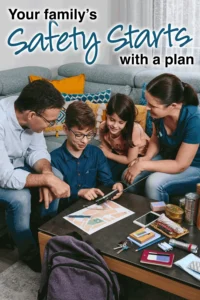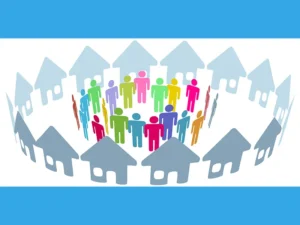Parenting Special Needs Magazine : January/February 2025
Sometimes, no matter how prepared we think we are, it’s not enough. Use this guide to prepare for emergencies, and download the attached handy family safety checklist.

From factors like medical requirements and mobility limitations to sensory sensitivities and diet restrictions, each can complicate standard safety measures.
Developing a customized emergency plan can address these concerns and ensure your child’s safety.
Here’s a comprehensive guide to creating an emergency preparedness plan tailored to your child’s unique needs.

Key Steps:
1. Develop a Personalized Emergency Plan
- Identify your child’s specific needs, including medical conditions, mobility support, and communication preferences, then plan with those needs in mind.
• Outline clear steps for different emergency scenarios (e.g., natural disasters, fires, medical emergencies).
• Create escape routes in case of fire, natural disasters, etc.
• Ensure all caregivers, family members, and close contacts understand the plan.
• Place the plan in an easily accessible location and tell others where it is.
2. Assemble an Emergency Kit
Some items to put in your emergency kit can include:
• Medications, list of all prescriptions, and medical equipment for multiple days
• Medical alert tags or IDs with your child’s health information
• Non-perishable food and water
• Communication aids (e.g., picture cards, tablets)
• Sensory support items (e.g., noise-canceling headphones, fidget toys)
• Comfort items like favorite toys or blankets
• Copies of important documents (medical records, insurance, emergency contacts)
• Battery-powered flashlight and radio, extra chargers
• Ensure you have a backup power source if your child relies on electrical medical devices

3. Establish a Support Network
• Identify trusted neighbors, family, and friends who can assist during emergencies.
• Share your emergency plan with them and ensure they know your child’s specific needs.
• Coordinate with medical professionals for backup care and guidance.
• Train all caregivers and family members to use medical equipment and follow the emergency plan.
4. Communicate with Emergency Services
• Notify local emergency responders about your child’s medical and sensory needs.
• Register with emergency notification systems in your area.
• Prepare for accessible transportation if evacuation becomes necessary.
5. Practice Your Plan Regularly
• Conduct practice drills with your child to familiarize them with emergency procedures.
• Adjust your plan based on feedback and observed challenges during practice.
6. Stay Informed
• Stay updated on weather alerts and local emergencies.
• Adjust your plan for seasonal risks (e.g., hurricanes, winter storms).
Here is one mom’s tornado story and how she learned that her plan was just not enough.
My daughter has special needs, and as such, we have had to work on many, many things in life, including the life skill of staying home by herself. We made our safety-stay-at-home plan (details in the story below) and rehearsed it repeatedly. Then we began leaving her home. She is so very proud of herself, and so are we!
And it has worked well, until one time….
On that one day, I had to go to a doctor’s visit, so I did our usual before-we-leave-our- daughter-home-alone checklist.
This includes reviewing safety measures for what to do if someone bangs on the door, the fire alarm goes off, or the toilet overflows, etc…
I also did the usual things, like giving her the list of phone numbers of people to call if needed and making sure she had both the landline and her cell phone.
I made sure the camera in the kitchen was working.
She knew who her “go-to” person was, and they knew they were the “go-to” person.
She was all set.
Feeling that things were in order, I left to go to my appointment, which was 15 minutes away.
And then it happened…out of the blue, now prior weather warning: A tornado.
A black sky, sirens going off, and torrential rain.
The office I was in was taking precautions and showing everyone to their designated safe space.
And all I could do was think, “SHE IS ALONE!”
ALONE IN A TORNADO WARNING
AND
I
CAN’T
GET
TO
HER
It was a terrifying few moments until I reached our neighbor, who earned her place in heaven that day. All I had to say was, “She is alone!!!” and my beautiful, beautiful neighbor said “I’m going now, I’ve got her.”
I reached Elizabeth next to tell her what was happening and what to do. She hates the dark, so simply sending her down there alone was not an option. She was calm and I told her that she was to put her shoes on and to stay on the line with me until she saw our neighbor and then she was to go…right away!
She did what I asked. When I heard the neighbor in our garage, she said, “I love you” and then hung up.
It was an equally terrifying few moments knowing that in this horrible storm, two precious people were making their way across the street to the safe haven of my neighbor’s home.
Imagine my relief when my neighbor said, “Well, we were almost washed down the street, but we are here, safe and in robes right now.”
My hands would not stop shaking, and I had to work on staying calm and my breathing.
I made it home as soon as we got the all clear.
I went and got Elizabeth who was still calm and still slightly damp.
And then it hit me…I need to be better prepared! Yes, I did a lot, but it was clear it was not enough.
The gift in this experience is learning from this and doing something about it.
And I did.
I got a clear plastic purse (the kind that is allowed at concerts). I put in it a phone charger cord, a flashlight and a battery pack.
I also went into the basement and put a camera. This camera allows us to talk to each other.
Now, when I leave, she gets the bag, the list of people, both phones, and I know that, if needed, she can go to safety in the basement, and I can reach her via the camera.
I am still working through the anxiety I have leaving my daughter home, and I check the weather for any storms on the map EVERY TIME I leave…. I am afraid I will be doing this for a long, long time to come.
I know logically that I can’t fully prepare for every possible situation. But I want to be as prepared as possible and in ways that work with my daughter’s special needs so that she is as safe as she can be.

Recent Comments